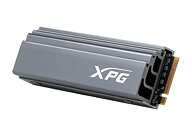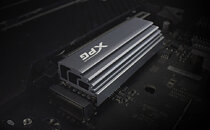Monday, September 21st 2020

ADATA XPG Launches GAMMIX S70 PCIe Gen4 M.2 2280 Solid State Drive
ADATA XPG, a provider of systems, components, and peripherals for gamers, esports pros, and tech enthusiasts, today announces the XPG GAMMIX S70 PCIe Gen4x4 M.2 2280 solid state drive (SSD). With the launch of the S70, XPG now offers a comprehensive lineup of Gen4 SSDs, which includes the GAMMIX S50 and S50 Lite, to meet a range of budgets and needs. With the adoption of next-gen PCIe 4.0, the GAMMIX S70 delivers unmatched read and write performance and has the distinction of being the world's fastest M.2 SSD.
With the advent of 5G networks and the ever-growing volume of data being processed, PCIe Gen4 is a critical upgrade that will bring storage devices to the next level. The GAMMIX S70 expands XPG's Gen4 SSD series with a new option for discerning users seeking to harness the best that PCIe 4.0 can offer. Sporting blazing-fast read/write speeds of up to 7400/6400 MB per second. Users will have no doubt they have reached the pinnacle of SSD performance. In combination with NVMe 1.4 compatible, Dynamic SLC Caching, the S70 offers performance far superior to that of SATA and PCIe 3.0 SSDs. For added ease of use and convenience, the S70 is backward compatible with PCIe 3.0.For reliable operations and stability, the S70 is equipped with XPG's proprietary CoolArmor heat spreader design. The aluminium heat spreader features a terraced structure, which resembles layers of armor, for increased surface area and hollow chambers underneath. This design provides for more effective heat dissipation that can reduce temperatures by up to thirty percent.
On top of its main performance parameters, the S70 supports LDPC error correcting code technology to detect and fix a more comprehensive range of data errors for more accurate data transmissions and a higher Total Bytes Written (TBW) rating. Also, with End-to-End (E2E) Data Protection and AES 256-bit Encryption, the S70 ensures data security and integrity. All of the components encased in the S70 have passed meticulous screening, testing, and certification to provide a reliability product of the highest quality. The S70 comes in 1 TB and 2 TB variants and is backed by a 5-year warranty.
With the advent of 5G networks and the ever-growing volume of data being processed, PCIe Gen4 is a critical upgrade that will bring storage devices to the next level. The GAMMIX S70 expands XPG's Gen4 SSD series with a new option for discerning users seeking to harness the best that PCIe 4.0 can offer. Sporting blazing-fast read/write speeds of up to 7400/6400 MB per second. Users will have no doubt they have reached the pinnacle of SSD performance. In combination with NVMe 1.4 compatible, Dynamic SLC Caching, the S70 offers performance far superior to that of SATA and PCIe 3.0 SSDs. For added ease of use and convenience, the S70 is backward compatible with PCIe 3.0.For reliable operations and stability, the S70 is equipped with XPG's proprietary CoolArmor heat spreader design. The aluminium heat spreader features a terraced structure, which resembles layers of armor, for increased surface area and hollow chambers underneath. This design provides for more effective heat dissipation that can reduce temperatures by up to thirty percent.
On top of its main performance parameters, the S70 supports LDPC error correcting code technology to detect and fix a more comprehensive range of data errors for more accurate data transmissions and a higher Total Bytes Written (TBW) rating. Also, with End-to-End (E2E) Data Protection and AES 256-bit Encryption, the S70 ensures data security and integrity. All of the components encased in the S70 have passed meticulous screening, testing, and certification to provide a reliability product of the highest quality. The S70 comes in 1 TB and 2 TB variants and is backed by a 5-year warranty.




27 Comments on ADATA XPG Launches GAMMIX S70 PCIe Gen4 M.2 2280 Solid State Drive
For the 4K Q64T8 and Q32T8 results, my "old" Patriot Viper VPN100 has better read performance and it even beats it in the Q16T8 test. Write speeds are also only slightly faster. It really shows that we need a wider controller/NAND bus to gain any useful performance advantage over current NVMe drives. Alternatively we need a new type of NAND.
Here's my OS drive, an even older WD Black SN700 which also beats it in all of the read tests, by quite some margin.
At least capacity starts at 1TB, which implies 512GB SSDs are one the way out.
Something along the lines of this makes more sense for laptops.
www.anandtech.com/show/16012/the-sk-hynix-gold-p31-ssd-review
It'll be interesting to see what DirectStorage will bring for games for example. That will obviously bring with it a new set of potential things to test and compare.
I see the 4K numbers (low que depths) as a simple filter between drives I would consider and drives I won't consider, since the sequential speed numbers are simply not interesting any more.
I haven't worked with ADATA but I have written a whitepaper on SSD ML recently (which is under NDA) - I largely agree it's fluff and primarily for marketing, however it would be a big mistake to disregard the fact that the vast majority of gains in flash and NAND performance have come from increasingly complex algorithms. AI/ML in particular benefits more on the enterprise end, especially with cTLC as a budget option, however it's already used and will be used on consumer drives (e.g. Samsung's flash) to improve tR (latency) but more importantly keep the drive performing better, longer. You have far less degradation of performance after writes and wear due to the improved read retry cycles, and it also enables you to do better programming (e.g. 8-16 vs. 4-8-16) including with interruptions (i.e. doing a read mid-program sequence). So while that seems minor to the consumer, it means you can get more out of the flash.
NVIDIA tried client ML with Tensor cores in the original RTX with DLSS, and it worked so well that they fell back to using algorithms they've pretrained themselves for DLSS 2.0... ML for individual consumer workloads still has a long way to go before it's actually a thing.
I'm all for better QLC performance, I more meant that it can be deceptively good for example in reviews or specification listings. One could argue that if the consumer doesn't ever "see" it then it's not relevant - which is a valid point, but underlines that NAND is a very murky business. See the recent Level1Techs stream with Malventano to see what I mean.
I can assure you this is something discussed at great length by reviewers since I talk to almost all of the prominent ones at this point. More generally the ability to benchmark has improved the last two years and information has been much better-shared. That being said, staying cutting-edge requires a lot of research and keeping up with the technical side (through conferences and such, livestreams more commonly now, but also reading academic journals and patents). Applying that to "real world" testing is more difficult as I find the engineers to be reticent to reveal proprietary information - for example, I had to track down patents for Crucial's P5 SLC caching scheme as they wouldn't tell me anything. And I had to study their flash geometry (tiles and circuitry) to determine the difference between B27A and B27B since they refused to say. I'm getting off track though - I suspect that, at least for now, 4K isn't really the bottleneck for most things (although software could and will improve), so a better measure is consistency, however most drives this generation will be focused on efficiency and sequentials.I think he was replying to my mention of AI/ML (example, example 2) - you're right, it's more of a "buzz" thing. I suppose I should have been more clear and just said they are utilizing adaptive algorithms to improve the flash. Although, this certainly involves feedback and learning at least in enterprise. It's unfortunately not something that's going to go away, what with Tensor cores in RTX cards for example.
I agree that it will be a while for DirectStorage (and thus related technology like RTX IO) but either way, it's clear the PS5's storage claim to fame isn't ultimately that impressive.
As for DirectStorage, does it matter if it's now or next year, or later? I was simply saying it'll be one more thing where SSDs will have an impact and it'll one more thing that can hopefully be benchmarked to show us another difference between drives.
What kind of monkey installs a PCIe 4.0 M2 SSD on a 3.0 compatible mobo ?
PCIe SSDs still have a long way to go, pushing speeds to the limit isn't the problem.